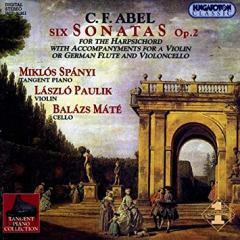Abel - Six Sonatas, Op.2 (2001)
Abel - Six Sonatas, Op.2 (2001)

Keyboard Sonata No. 1 in C major 1 I. Allegro moderato 7:13 2 II. Tempo di menuetto 5:28 Keyboard Sonata No. 2 in F major 3 I. Andanto 6:58 4 II. Allegro assai 4:14 Keyboard Sonata No. 3 in D major 5 I. Un poco vivace 7:10 6 II. Gigue 2:48 Keyboard Sonata No. 4 in B flat major major 7 I. Allegro moderato 6:10 8 II. Tempo di menuetto 2:49 Keyboard Sonata No. 5 in G major 9 I. Vivace 5:08 10 II. Scherzo: Presto 1:57 Keyboard Sonata in E flat major 11 I. Moderato 6:14 12 II. Andante 3:09 13 III. Menuet 2:01 Miklós Spányi (Piano) László Paulik (Violin) Balázs Maté (Cello)
It’s easy to imagine that a disc of sonatas for harpsichord “with accompaniments for a violin” by Carl Abel is pretty close to scraping the bottom of the 18th-century musical barrel, but in this case the description is particularly apt because the recording’s cavernous, almost ear-mangling resonance gives the impression that these musicians must have been playing from the bottom of one. Worse, we also get the glassy, edgy string sound reminiscent of some early digital recordings, even though this one was made last year. Yes, Abel, a German bass viol player who spent many years in London in a successful musical partnership with J.C. Bach, is a competent enough composer, but these stylish, agreeable, yet rather underdeveloped chamber pieces are firmly of the home-consumption variety and as such hold far more interest for the player(s) than the listener. Harmonically pleasing and sometimes clever, tuneful but never really challenging to the ear or intellect, these sonatas offer a good example of the kinds of music furiously cranked out by composers of all ranks during the latter 18th century to satisfy a growing domestic market. Of some interest here is the use of a tangent piano (about which there is an extended discussion in the liner notes), an early keyboard instrument whose “tangent action” rivaled the “hammer action” of other “pianos” of the period. The general sound is much like a harpsichord, but modified by the effect of wooden tangents striking the metal strings.
Despite the indication in the title that suggests the keyboard is the dominant voice and the violin a secondary, accompanying one, the two instrumental roles in fact are equal in importance, supported by a “continuo” cello. The performers–expert players all–seem to happily observe the music’s modest proportions and technical demands, successfully bringing out its lyrical qualities and attempting to maximize its potentially appealing sonorous effects. However, the ghastly engineering negates most of their efforts, leaving us with little to recommend, even as background music. ---David Vernier, classicstoday.com
download (mp3 @320 kbs):
yandex mediafire ulozto gett bayfiles








